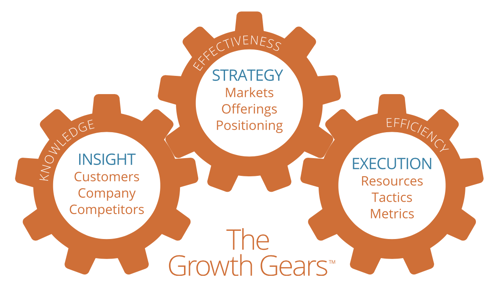CEO Blog - Advice for CEOs on growth and scaling
Transform Marketing into a Growth Engine – A Roadmap for Industrials

Questions every CEO should be asking their Marketing team
Even in our enlightened times, industrial manufacturing CEOs still struggle to define the appropriate role for marketing in the go-to-market paradigm.
Many industrial manufacturers, spanning start-ups to Fortune 500 manufacturers, still make the mistake today of marginalizing marketers into a role of pretty pictures, parties, and promotions.
A recent conversation I had with a newly hired CMO of a $3B industrial manufacturing company validated this premise – he was surprised to discover that the marketing function in 2021, decentralized across the global business units, had the primary focus of marketing communications, or MarCom.
While MarCom is an important function, it’s not the key accountability that will make the difference between profits and deficits. It’s a tactical role that requires a significant amount of strategic pre-work to foster success.
Indeed, when the full organization aligns around a market-based strategy, a different level of performance – and profitable growth -- is achievable.
Industrials of all sizes have a great opportunity today to compound the value marketing delivers by aligning behind a marketing ideal that leverages a framework encompassing all 4 Ps of the marketing mix (Product-Place-Price-Promotion).
So, how does a company build out this market-based framework?
At Chief Outsiders, we refer to this simple effective framework as the Growth Gears™ – three co-dependent cogs that interlock to produce go-to-market success. As you can see in the graphic, the three gears are: INSIGHT – STRATEGY – EXECUTION
Learning how to use these gears to drive go-to-market plans can be a difference-maker. Let’s take a closer look at each gear, and the questions you need to ask to effectively implement each gear:
Insight
This gear encompasses strategic relevance – focusing on customers, competitors and company.
CEOs need to challenge Marketing to answer these critical questions related to INSIGHTS:
- Where are our current profit pools?
- Which core markets do we serve?
- What is the market size of the various segments we serve in our core markets?
- What is our market share in these core markets?
- What are the key drivers of growth in these core markets?
- Who are the small, medium and large customers in these core markets?
- What is our share of wallet in these customer accounts?
- What are the primary competitive forces in our core markets?
- Which core market segments represent the most attractive white space?
- What are the priority key gaps that must be addressed in our core markets?
- Based on the above – what are our strategic hypotheses / options for driving profitable sustainable growth?
Strategy
Once Insights have been assessed, the Strategy gear can effectively be developed. Here, our goal is to specifically articulate how the business will drive organic growth, encompassing target market segments, target customers, product and service roadmaps, value proposition positioning, strategic pricing, brand-channel, go-to-market, content, and digital technology.
CEOs needs to challenge their marketing leadership to answer these critical questions related to strategy:
- Which priority core market segments will we target to drive profitable growth?
- Which priority customers will we target in these priority market segments?
- How does our value proposition differentiate us to drive competitor conversion?
- Which existing products will we leverage to gain deeper penetration into target existing and new market segments/accounts?
- Which new products will we develop to gain deeper penetration into target existing and new market segments/accounts?
- How will we institute pricing actions to profitably grow revenue and market share?
- How will we go-to-market to gain deeper penetration into target accounts?
- How do we anticipate competitors will respond and what is are our counteractions?
- How do we leverage digital to scale the value proposition and drive conversion?
- Have we assessed the top risks and defined risk mitigation actions?
- Have we clearly defined our top 3-5 strategic and actionable growth levers to effectively drive profitable sustainable growth?
Execution
Now that insights have been gathered and strategy has been honed, the execution gear can be efficiently developed. Specifically, at this stage, you’ll define which tactical activities will be funded, staffed, and implemented to drive profitable, sustainable organic growth. Typical activities at this stage include content marketing, digital marketing, social media, literature, POP displays, events, tradeshows, advertising, public relations, and KPIs.
CEOs should challenge their marketing leadership to answer these critical questions related to execution:
- Are the critical actions within each function of our organization aligned with the priority growth levers defined in our market-based growth strategy? How do they align with each of the following cross-functions:
- CEO – Market-driven vision for growth
- Finance – Growth / margin / capital efficiency
- Operations – Productivity / direct labor efficiency
- Supply Chain – Vendor management - cost reductions / inventory optimization
- Engineering – New product development / extensions / sustaining
- Marketing – Insights / strategy / execution
- Sales & Customer Service – Commercial execution / sales effectiveness
- What are the priority metrics which will keep us focused on driving the right results and will ensure our growth strategy is working?
Though the road to marketing respect is fraught with pre-conceived notions, this framework should help you to gain momentum on your growth-centric aspirations – while better defining the role that marketing has in bringing it to life.
If I or any of my fellow Chief Outsiders can be of any assistance to you in turning your own Growth Gears™, please reach out.
Topics: Marketing Strategy, Manufacturing, Growth Gears, Industrial
Wed, Jun 9, 2021- Press Releases
- Careers
- Case Studies
- Marketing Consultant Company
- Marketing Strategy Consultants
- Marketing Plan Consultants
- B2B Marketing Consultants
- Virtual CMO
- Marketing Consultant Outsourcing
- Fractional CMO
- What is a Fractional CMO
- Healthcare Marketing Consultant
- Marketing Consultant Houston TX Texas
- Marketing Consultant Texas TX
- Marketing Consultant Bay Area
- CEO Blog
- Ebooks Plus
- Executive Marketing Consultants
- Product Marketing Consultants
- B2C Marketing Consultants
- Virtual Marketing Consultants
- Senior Marketing Consultants
- Temporary CMO
- Hire a CMO
- Fractional CMO Salary
- Fractional CMO Responsibilities
- Marketing Consultant Austin TX Texas
- Marketing Consultant Dallas TX Texas
- Marketing Consultant San Antonio
- Helping Private Equity
- Private Equity Blog
- Leadership Team
- Privacy Policy
- Business Marketing Consultants
- Strategic Marketing Consultants
- Marketing Technology Consultants
- Sales and Marketing Consultants
- CMO Job Description
- CMO Salary
- Fractional CMO Agency
- Fractional CMO Services
- CPG Marketing Consultant
- Marketing Consultant San Diego
- Partners
Houston, TX 77056
© 2023 Chief Outsiders



